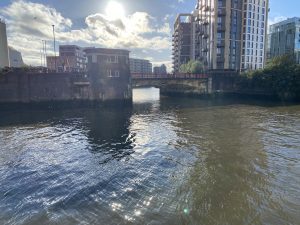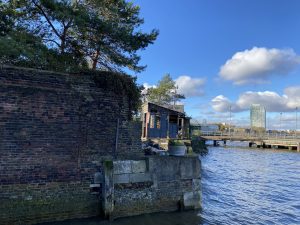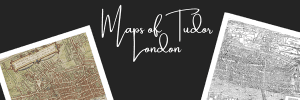Henry VIII built the first permanent tiltyard (for jousting) in England at his palace in Greenwich – and everyone knew where it was more or less. This was because we have lots of paintings from the seventeenth century showing it in relation to the Queen’s House, which was built between 1616 and 1635 by architect Inigo Jones and still stands today. The Tudor Palace, along with its tiltyard fell into serious decay during the Civil War and after, and its remnants were finally pulled down in Charles II’s reign.
There remained a problem though: the various paintings differed in its exact position. This was resolved to everyone’s satisfaction when in the nineteenth century workers extending the railway from London Bridge which then ended at Greenwich station found some Tudor bricks, and it was thought that these came from the bases of two towers in the tiltyard.
A few months ago, though, researchers from the University of Greenwich using ground-penetrating radar found the distinctive marks of the towers. The results of their labours, which were released in October 2020, have placed the location in front (to the north) of the Queen’s House) 100m further towards the eastern boundary of what is now the grounds of the Maritime Museum.
Henry’s tiltyard was spectacular. Two grand towers with octagonal bases (whose footprint was thus distinctive once located) were joined by a large gallery, forming a grandstand from which to watch the events. In front of this was a long rail running down the centre of the yard, which divided the riders as they galloped towards each other at great speed.
Henry’s last joust took place in this yard in 1536. He was thrown from his horse, and his steed fell on top of him. Contemporary accounts imply the king was unconscious for two hours. It is likely that Henry also suffered an injury to his leg, causing an ulcer which never healed.
This in turn may have had a sinister influence on events at his court. Henry was well-known for executing discarded favourites and people he perceived to be a threat to him. The last of these was Henry Howard Earl of Surrey who was beheaded on 19 January 1547, His father, Thomas Howard Duke of Norfolk was due to meet the same fate on 29 January, but luckily for him the king had died the day before at the age of 55.
Some historians have speculated that Henry VIII’s cruelty was due in part to the constant pain he may well have been in following the accident in Greenwich, though the earlier Henry of pre-jousting fall times does not appear to have been particularly reticent when it came to putting people to death either. Perhaps on more solid ground is the fact that after the accident the king probably stopped exercising and became the obese figure of his later portraits by Holbein.
–
Find out more about Greenwich. Book tickets for Ian McDiarmid’s Greenwich London Walk now. Private tour also available here.



